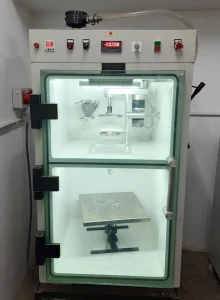Enquiry
Vacuum Casting
We accurately reproduce the prototypes with original color, over-mold, texture and geometries from the master model and components.
We have a vacuum casting machine, which can cast prototypes with the max dimension up to
800 x 800 x 600 mm.
Vacuum casting is excellent way to make small batch (10 to 50) of prototypes from wide range of polyurethanes, which can simulate ABS,PMMA,Rubber,PP,Nylon, etc.

Application of Vacuum Casting

Vacuum casting service has a wide range of applications in various industrial fields, such as medical equipment, aviation, automotive industry, electronic products, etc. When you need a small quantity of production-quality plastic parts (from 10 to 50 sets), you should choose vacuum casting to avoid the long lead time and high cost of creating plastic injection mould tools.
These parts are used in prototypes and display models to verify the fit and function of a new design. In some instances, vacuum casting can also be used for end-use parts. Because the casting polyurethane can simulate the properties of ABS, Nylon, PP, PMMA, and soft TPE rubber.
Our Vacuum Casting Capability
800 x 800 x 600 mm

Vacuum Casting Material
The materials used in Vacuum Casting can simulate the following production materials and properties:
Rubber : high flexibility
ABS : high rigidity and strength
Polycarbonate and PMMA : shock resistance, translucence, high temperature resistance
Polypropylene and HDPR : high elasticity
Polyamide and glass filled nylon : high rigidity
Filled ABS : fire resistance and retardance
Vacuum Casting Process
3. Mold cutting and RP model removal
4. Polyurethane or other material casting

Before making the silicone mold, you need to make an master patterns, which can be made by CNC processing or 3D printing. Start making the silicone mold, and mix the silicone and curing agent evenly. The appearance of the silicone mold is a flowing liquid, and the component A is silicone. The B component is the curing agent.
Vacuum and bubble removal treatment:
After the silica gel and the curing agent are evenly stirred, perform the vacuuming to remove the bubbles. The vacuuming time should not be too long. Under normal circumstances, it should not exceed ten minutes. If the vacuuming time is too long, the silica gel will solidify immediately, resulting in a cross-linking reaction. The silica gel becomes piece by piece and cannot be painted or poured.
Painting or operation process:
The silica gel that has been evacuated and evacuated can be brushed or poured. Pour it on top of the product (Note: The product or model to be copied before pouring the silica gel must be coated with a release agent or release agent). Then apply the silica gel on the product. The application must be even. After 30 minutes, paste a layer of gauze and weft cloth to increase the strength and tensile force of the silica gel.
Production of outer mold:
The generally used method and material is to surround the mold with rubber sheets or wooden boards, and fill the mold cabinet with plaster. The other method is to use resin brushing. After applying a layer of resin, a layer of glass is pasted. Fiber cloth, brush and paste, repeat two or three layers to complete the outer mold of the mold.
The operation method of filling mold or pouring mold:
Pouring molds or perfusion molds are used for relatively smooth or simple products. There is no mold line to save labor and time, that is, to copy the product or model you want to copy, pour the vacuumed silica gel directly onto the product, and wait for the silica gel to dry and form After that, take out the product. (Note: The perfusion mold is usually made of soft silicone, so that it is easier to demold and will not damage the product in the silicone mold).
Tolerances of Vacuum Casting
A shrinkage rate of 0.15 % is to be expected in general.

